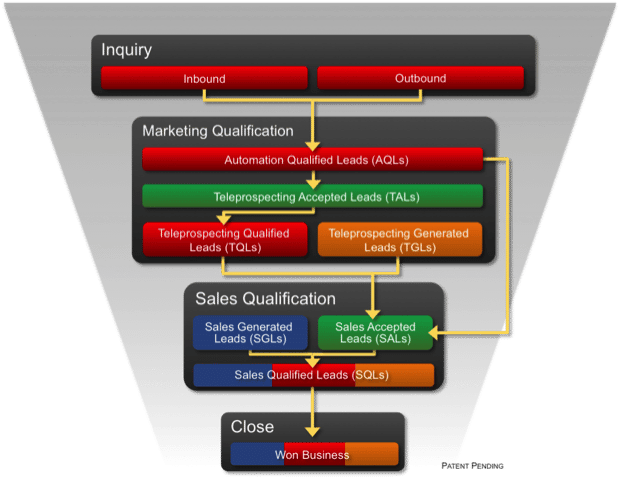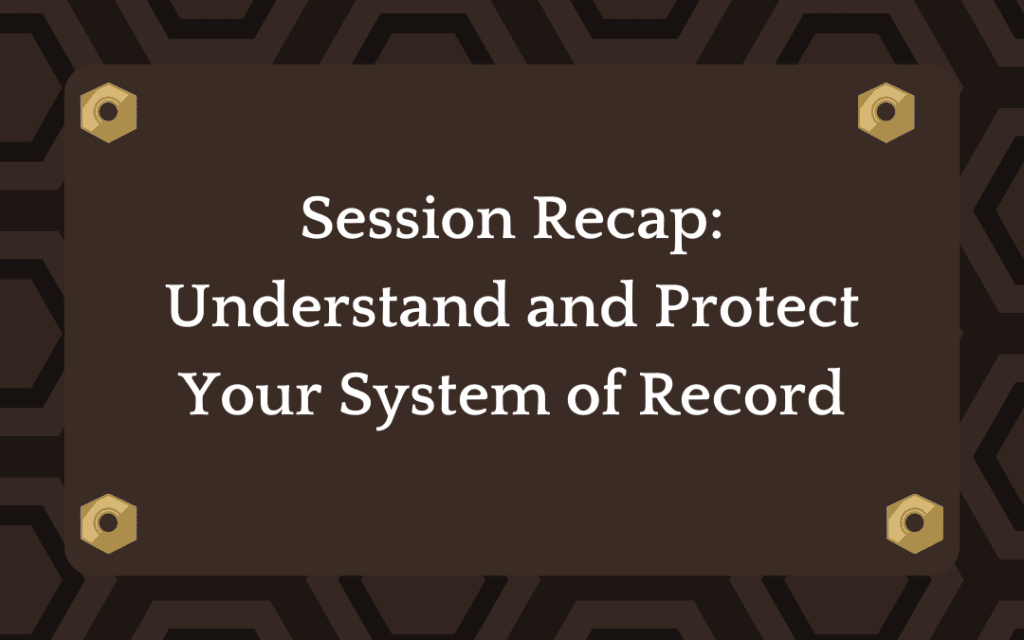The end of 2022 is near, so sales and marketing teams are planning for 2023 to identify and set goals for the coming year.
To do this, you should start by reviewing your 2022 goals and KPIs to assess how you performed and what adjustments need to be made for the next year. This means your sales and marketing system of records (your CRM, marketing automation platforms, and other reporting tools) will be front and center in those discussions. For many teams, these check-in conversations happen weekly or monthly but become especially important now as you map out budgets and commitments that will define success for your team in 2023. This also means that any cracks in defining your goals become more apparent and detrimental to team communication.
Last week, Stack Moxie’s CEO spoke at MarDreamin’ to share how teams can better align their systems of record. This ensures everyone is on the same page about where and how goals are tracked and their definition of success. Not only does this make end-of-year discussions easier, but it also helps keep teams collaborative year-round with the same perspective on the state of important KPIs.
To see the full talk, watch the recording from MarDreamin’.
The importance getting alignment on your sales and marketing system of record
With so many different systems tracking similar metrics, it’s imperative for your team (and the other teams who care about those metrics) to be in agreement on how and where your goals are being measured. Aligning your system of record is fundamental to understanding the true state of your KPIs, which enhances transparency and accountability for the employees responsible for managing them.
Having a defined place to track your goals’ progress helps your team stay coordinated as you work towards achieving them. If a certain metric is measured by two different systems and is seemingly on track in one while being at risk in the other, it causes a divide among your people. The teams who look at one will assume that they are on the right track and will miss the opportunity to make changes to fix the issue, while the teams who look at the other will take steps to make up the progress that may not be necessary.
In either case, your organization is on different pages about how they’re currently tracking for reaching the goal and taking different approaches to how they perform. When it’s time to evaluate progress, disagreements will arise because two numbers tell different stories.
These debates not only waste time but also harm the trust and communication that exist among your teams. To protect teamwork and get the most out of your efforts, it’s important to work to get back on track and move forward together.
Example: Time to follow up with a lead
Lead conversion decays the longer it takes for a sales representative to follow up, which makes timely response critical. But if you ask different teams what the average time is for an SDR to follow up with a lead, you’ll find that how people define that varies. The admins overseeing the sales teams’ systems may be timing it from when a lead is created in Salesforce to when it lands with a rep, and they follow up. For others, their watch may not start until the lead lands in a sales rep’s queue until the rep follows up.
But when you meet to report on these follow-up times and try to understand how time decay affects conversion, you’ll probably find that neither of those numbers is very helpful. From a lead’s perspective, the countdown to follow-up begins the moment they fill out the form or take the action that shows they want to engage with your team.
An explicit definition or SLA of “time to follow up with a lead” is critical and should include the exact moment you want the tracking to begin. That way, every team can understand what’s expected of them and come prepared with the numbers your organization is looking for and a better idea of how they’re performing.
Getting started with aligning your system of record
To begin, you need to understand your tech stack and how the current data you own is managed. This gives you the foundation to decide which systems should have the final say on metrics and KPIs and helps you communicate that to each team.
Having a published tech stack diagram is helpful since this gives you a full view of how your technologies are currently laid out. You can also start by simply discussing with the appropriate teams the technologies they use and their current methods for measuring KPIs. The most important thing is knowing which systems are available so you can evaluate how to define the best one for each metric.
It’s also key to learn how other teams operate so that you can understand their current processes for tracking metrics and consider them as you create something for everyone in the organization to follow. It gives you additional insight into what each system currently does and helps you make better decisions about which systems should remain the go-to for a particular KPI.
Once you know the technologies, you should also consider how data is currently being managed. Who owns the data that drives your goals? By defining those people, you can see if there are any blind spots or metrics without owners that need to be assigned and can begin building a definitive system of record across teams.
Defining your system of record
It’s worth mentioning that before you define your system of record, you need to understand the metrics you want to track with it. These should be less system-focused and more related to the business metrics you’re trying to accelerate.
You can bring your team together and drive alignment by sharing this quarter’s KPIs and where they’re being tracked. Ensuring everyone understands where those goals are updated and can see the progress made towards them at any given time goes a long way in supporting your team throughout the quarter.
As you build out an agenda for this meeting, consider the following:
- Reviewing the map of all your systems to understand how data flows through it
- Discussing how data is pushed and how it’s accepted
- Create a data map to align your team on your systems of record for each KPI and how they fit together
- Establishing a cadence to review these regularly
Best practices for aligning your sales and marketing system of record
Documentation & Communication
If people depend on the technology you manage to track one of their KPIs, transparency about managing it is imperative. Publish SLAs related to your system that everyone can see, so there are clear expectations about integration speeds and reporting notifications that others can use to manage how they work.
Recommended Reading: How Does RevOps Move from Tactical to Strategic? It Takes Trust
It’s also important to consider how you manage outages for the systems other teams rely on. A clear process for handling errors, from reporting to fixing them, allows others to adapt their work as needed.
Plan your KPIs
Driving alignment on your KPIs and what “success” looks like for each is fundamental to improving overall performance. Having a glossary of KPIs and links to a live dashboard where they’re tracked allows everyone to check progress and have visibility into company priorities.
And before you publish them, have a conversation with everyone involved to agree on an explicit definition of each KPI and an explicit definition of where it is tracked or what its system of record is.
Have the hard conversations
There will be challenges whenever you take on a new KPI or introduce a new process that influences it. Understanding that before conflict arises, and taking proactive steps to mitigate, minimizes time and trust lost later.
Implement a weekly cadence to discuss challenges and work together to identify their root causes. Continuing this practice until it becomes overkill because there are no longer new issues to discuss regularly is a great way to build transparency. Once you feel comfortable stopping the weekly meetings, please keep the conversation open to address any new challenges as they arise.
Two systems of record, one metric
Certain metrics might be trackable on multiple systems. While it’s important to define the single one that serves as the entire organization’s source of truth for reporting purposes, there’s value in seeing the same KPIs expressed in different ways.
An example: The demand waterfall

MQLs, or marketing-qualified leads, and SALs, or sales-accepted leads, track slightly different numbers, but in theory, they should be identical. If Marketing has deemed a lead qualified, it’s usually expected that this lead would also exist in your CRM and be assigned to a salesperson.
So then, why is it that when you check your marketing team’s system and compare it with the system used by sales, you see two different numbers?
There are always minor differences between technologies and processes that can lead to a discrepancy like this. Having two systems, and seeing that these numbers are different, can be extremely valuable to understanding how your revenue tech stack works and where issues exist within it. It makes you aware of technology problems and leads routing issues, allowing you to be aware of them and make the appropriate fixes.
Are integration issues slowing your team down? Sign up for a free account to tame your tech stack.
Looking at all the different systems where a KPI is tracked, in addition to the primary one deemed its official system of record, once again drives alignment on how different teams are working and how data flows through your tech stack.
Protect your system of record (your digital life depends on it)
Aligning your system of record and implementing the above best practices isn’t meant to be hard and shouldn’t be time-consuming. It’s an exercise in documentation and agreement that you can build into your organization’s processes to communicate and plan.
If your system of record isn’t aligned, your KPIs and metrics invoke unnecessary disagreements and break trust and progress. Putting in the work needed to set it straight will have a massive impact when planning and assessing goals become a matter of simply reviewing your defined source of truth.
Not sure where breaks are happening in your tech stack? Our robots can help.
The better your tech stack is running, the easier it is to map it out and decide which system owns which KPI. Stack Moxie gives you full, developer-level observability into your revenue tech stack so you can see where issues with integrations, site pages, lead routing, and other breakdowns are happening and fix them fast.
Sign up for a free trial or talk to a project manager to get started.

